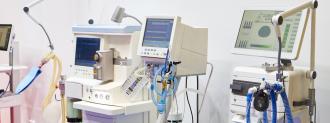Twenty-six physicists have teamed up to design a low-cost coronavirus ventilator they say would be easy to mass produce — something the world desperately needs right now.
A patient with a severe case of COVID-19 can find themselves unable to breathe on their own. Until that ability returns, a ventilator can force air into and out of their lungs.
However, the surge in COVID-19 cases has left many hospitals with far fewer ventilators than patients in need of the machines — but this new design could increase the supply.
A New Coronavirus Ventilator
On March 23, the group published a paper in the pre-print journal arXiv detailing its coronavirus ventilator, which it calls the Mechanical Ventilator Milano.
According to that paper, the design of the MVM is based on the Manley Ventilator, a simple but reliable ventilator developed in the 1950s.
While that machine incorporated mechanical switches, however, the new coronavirus ventilator is designed to be controlled by a computer over WiFi.
The researchers say the MVM needs just two things to work — electricity and either oxygen or compressed medical air — and is easy to operate.
It can be built using only off-the-shelf parts available at a typical hardware supplier for a few hundred euros, which converts to roughly $330.
The researchers are working as a breakneck pace to bring their design to fruition — according to the arXiv paper, they performed the first functional tests on March 20, started engineering prototypes the next day, and were building the prototypes just two days later.
The leader of the group, Princeton University’s Cristiano Galbiati, told Physics World it hopes to complete that first prototype by March 28 and is currently focused on building the necessary computing software.
The group has launched a GoFundMe campaign to raise money to produce the first few test units of its coronavirus ventilator, but is still awaiting formal regulatory approval, which will need to come on a country-by-country basis.
Even if Galbiati’s team gets that approval, it has no guarantee that anyone will produce its coronavirus ventilator units quickly enough and in large enough quantities to effectively address the shortage.
“I don’t know the answer to that yet,” team member Art McDonald told Physics World. “But we have a lot of very highly motivated individuals working on this.”
Saving COVID-19 Patients
Galbiati’s team isn’t alone in attempting to solve the world’s ventilator shortage.
British tech company Dyson has designed and built its own coronavirus ventilator, the CoVent, and is now working to fill an order of 10,000 of the units for the U.K. government.
Splitting ventilators is not something experts would condone under normal circumstances.
At the far more DIY end of the spectrum, cardiac anesthesiologist Stephen Richardson built a coronavirus ventilator out of a toolbox, wood, and a few scavenged parts — and then released his design online for anyone to replicate.
Others are focusing not on designing and producing new coronavirus ventilators, but scaling up the number of COVID-19 patients hospitals can treat with the ones already available.
To do that, groups from Belgium’s hospital Geel and South Carolina’s Prisma Health have unveiled techniques to split a single coronavirus ventilator between multiple patients while minimizing risks.
Splitting ventilators is highly controversial and not something experts would condone under normal circumstances. But the current situation is far from normal, and the technique could buy hospitals — and COVID-19 patients — valuable time while they wait for the arrival of more ventilators.






